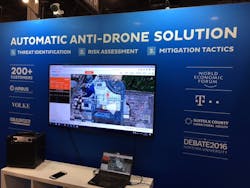Las Vegas – The security industry has been abuzz in recent years about the potential uses for drones in video surveillance deployments; however, there has been as much, if not more, concern about the threats posed by unmanned aerial vehicles (UAVs) in the wrong hands. Whether it’s smuggling contraband into jails or delivering explosive devices on the battlefield, the nefarious applications for drone technology have been well documented.
In fact, the need to effectively protect facilities and critical infrastructure sites against the threats posed by commercial UAVs has led to a burgeoning anti-drone market. According to a report recently published by Grand View Research, the global anti-drone market is expected to reach $1.85 billion by 2024.
One company on the forefront of delivering anti-drone technology to the commercial security market is Dedrone, which is showcasing its DroneTracker technology this week at ISC West 2017 in Las Vegas. The DroneTracker platform leverages a multitude of sensors – radio-frequency scanners, microphones, cameras, and even radar – and combines them with a software package that enables end-users to quickly identify and track drones in their vicinity. For those agencies and entities that are able to legally, the company also offers signal-jamming technology that can drive drones away or force them to land.
“We’re looking for the typical command and control codes of the drone. So, we’re able to identify and localize the drone as well as the operator,” Dedrone co-founder and CEO Joerg Lamprecht says. “We’re able to read out specific information about the drone, such as the serial number, to uniquely identify it and provide information to improve situational awareness like where is it, how fast it is moving, when it’s going to be where, etc.”
DroneTracker has been deployed in a number of different applications around the world, including government embassies, stadiums, data centers and correctional facilities. It has also been used to secure several high-profile events in recent months, such as the World Economic Forum’s annual meeting in Davos, Switzerland, this past January and the presidential debate between Donald Trump and Hillary Clinton that was held at the UNLV Thomas & Mack Center in Las Vegas last October.
According to Lamprecht, the company was initially established three years ago in Germany but is now a U.S.-based business with a headquarters facility in San Francisco. Dedrone currently has over 200 customers worldwide. “In the beginning when we started the company, people said: ‘You guys are doing Star Wars-type stuff, we don’t see any drones,”’ Lamprecht says. “There were so many incidents afterward, though, the most prominent being the drone that crash-landed on the White House lawn and the one that landed on the prime minister of Japan’s rooftop with a bottle of radioactive material on board. I think this made people realize that drones are no longer toys. They can be fully autonomous with an autopilot feature and can carry large payloads long distances, so they can do really bad things.”
While it seems that an ever-increasing number of companies are coming up with ways to use drones for good, Lamprecht believes the market for anti-drone technology will eventually outpace that of commercial drones sales due to the inescapable threats they pose.
“Everybody who has a fence has a fence for a reason,” Lamprecht says. “I think we’re just at the very beginning of a really, really intense and long market trend that we’re going to see. There will come a point where it is absolutely normal, as you’re planning a new building, to have aerial security deeply integrated with your physical security and cybersecurity programs.”
Another company showing off their drone detection wares at this week’s show is DroneShield. The company, which was originally founded in Virginia but is now based in Australia, started selling its products about three years ago and are now deployed by a wide variety of end-users in 35 countries around the world.
Unlike some of the other solutions on the market, DroneShield leverages acoustic sensing technology to detect drones in flight. According to DroneShield CEO Oleg Vornik, their solution is capable of detecting a drone from up to three-quarter miles away.
“We can separate the sound of a drone from background clutter and then compare it to a database of drone signatures and if there is a match, the user gets an alert in real-time,” Vornik explains.
While acoustic sensing technology is often criticized for being unable to work reliably in noisy environments, Vornik says they’re worked hard to refine and perfect their solution to address these concerns. In fact, DroneShield has been used to protect the Boston Marathon for the past several years, which Vornik says has served as a proving ground for the technology’s ability to function in these exact types of applications.
In addition, DroneShield also sells a drone gun, a bazooka-like device that serves as a directional jammer. It can force an unknown UAV to return to its point of origin or land in a controlled manner, which Vornik says is key.
“If you can imagine a setting where perhaps you have a large gathering of people and a drone is flying with a bomb or anthrax strapped to it, the last thing you want to do is put a bullet through it or shoot a net over it because that creates the possibility of triggering the payload and doing the terrorist’s work for them,” Vornik says. “Instead, you want to push the drone away to where it came from in a safe manner and that’s what our jammer would do.”
Vornik says the company has ramped up its marketing efforts in the U.S. this year as they believe there is a significant opportunity to increase adoption of their products in a wide range of vertical markets across the country.
“We are looking to create more brand awareness with our customers. We are also looking to continue building relationships with security integrators. For most projects around the world, we rely on security integrators and their relationships,” Vornik says. “We also want to develop technology partnerships. We believe that we are the best in the world at acoustic drone detection, we believe we are excellent at drone jamming technology but are there other means of drone security? Yes, absolutely, and we are currently in discussions with a number of technology partners to build an integrated drone security platform.”
Like Lamprecht, Vornik sees a robust market for anti-drone technology moving forward and he believes end-users will demand multiple methodologies for detecting UAVs moving forward.
“Using different technologies improves the probably of overall detection, reduces false alarms and gives the user a better overall experience. The same thing with counter-measures, you want to layer counter-measures just like you would detection.” he says. “We see a day where just like fire alarms are mandatory in a lot of installations, drone alarms will be mandatory due to the risks they pose.”
About the Author:
Joel Griffin is the Editor of SecurityInfoWatch.com and a veteran security journalist. You can reach him at [email protected]


